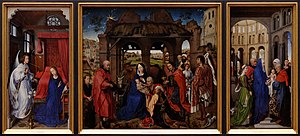Columba Altar

|
| Columba Altar |
|---|
| Rogier van der Weyden , around 1455 |
| oil on wood |
| 138 × 293 cm |
| Old Pinakothek |
The Columba Altar or Three Kings Altar is a triptych by the Dutch painter Rogier van der Weyden , which is shown today in the Alte Pinakothek in Munich. The painting, painted with oil paints on wood, was completed in 1455.
The altar got its name from its place of origin, the Cologne Church of St. Columba . It is not entirely clear who the donor of the altar is. It is possible that the patrician Goddert from Cologne ordered him from the Wasservass around 1450. In any case, the altar was in the Marienkapelle, which was built between 1458 and 1464 by order of the Cologne mayor Johann Rink. Rogier traveled to Rome in 1450. On his way there he saw the altar of Stefan Lochner's patron saint in Cologne . The Columba Altar can be seen as Rogier's attempt to outdo this work. If you look at his triptych, you can see z. B. again a young woman in green who can be seen on Rogier's right wing. Rogier's altar is closer to reality, while Lochner designs his altar in a very spherical, distant manner. In 1827 the altar was acquired from the Boisserée collection and hangs today in the Alte Pinakothek in room I, where it is one of the main works.
description
The central panel depicts the Adoration of the Magi, who are entering in a long procession. The holy family is in a dilapidated stable. In the middle sits Mary with the child who is venerated by the eldest kneeling king. The youngest king on the right is sometimes interpreted as an idealized portrait of Charles the Bold . The founder kneels on the far left behind Josef . Behind the stable opens a wide landscape with hills and a town and on the far right you can see part of a temple.
The Annunciation of Mary can be seen on the left panel . It takes place in a magnificent bedroom. The angel greets Mary, the Holy Spirit hovers through the window as a dove symbolized, and lilies stand on the floor as a sign of virginity.
The right wing shows the offering in the temple on the 40th day after birth, which the Mosaic Law prescribes for all firstborn. The prophet Hannah recognizes Jesus as the Savior and the aged Simeon , who could not die before he saw the Savior, agrees to praise him (the Nunc dimittis ). A maid holds pigeons ready for the prescribed sacrifice.
Van der Weyden stands out for its ability to give clothing a special materiality. It gives the gold a special shine, so that it looks real, just like all other colors are very clear and radiant. Even Johann Wolfgang von Goethe admired the picture in 1814 when he saw it in Heidelberg and said that everything was painted with the same care, that there was no place on the boards that could not be seen through a magnifying glass. Until 1841 the altar was considered a work by Jan van Eyck and was admired as such by Goethe.
But not only the quality of the painting distinguishes the picture. Van der Weyden has also incorporated many symbols. The cross in the manger already refers to the sacrificial death of Jesus, on the prayer chair Mary the fall of man is carved, which she compensates with the birth of Christ. The interior of the temple is late Romanesque and symbolizes the Old Covenant, the outer space on the central panel is Gothic and symbolizes the New Covenant.
literature
- Dirk De Vos: Rogier van der Weyden. The complete work . Munich 1999, here: Catalog No. 21 (pp. 276–284)
Individual evidence
- ↑ www.pinakothek.de ( Memento of the original from October 20, 2013 in the Internet Archive ) Info: The archive link was inserted automatically and has not yet been checked. Please check the original and archive link according to the instructions and then remove this notice. Rogier van der Weyden → Columba Altar: Adoration of the Magi. Accessed October 19, 2013
